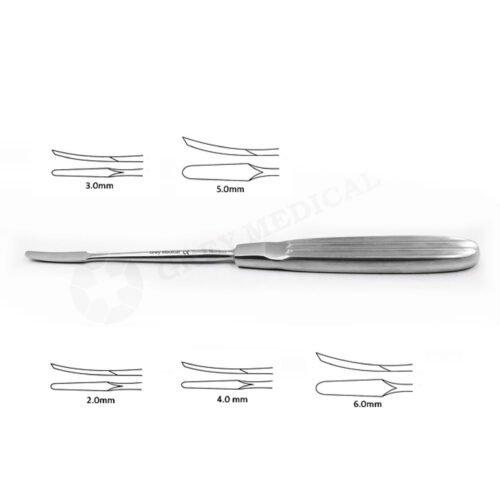Understanding the Raspatory Surgical Instrument

In the precise world of surgery, every instrument has a specific and critical role. While scalpels and forceps are widely recognized, other specialized tools are just as essential for successful surgical outcomes. One such instrument is the raspatory surgical instrument a key tool used by surgeons in a variety of disciplines. Understanding its function, design, and applications reveals the level of detail required in modern surgical practice.

What is a Surgical Raspatory?
A surgical raspatory is a specialized orthopedic instrument designed for scraping, smoothing, and separating tissue, primarily bone and periosteum (the dense membrane covering bones). Its name comes from the verb "to rasp," which means to file or scrape with a coarse instrument. True to its name, the tool often features a textured or sharp working end that allows surgeons to carefully modify bone surfaces or lift tissues away from bone without causing unnecessary damage.
The design of a raspatory can vary significantly depending on its intended use. Some have delicate, fine tips for intricate work in areas like neurosurgery or otolaryngology (ear, nose, and throat surgery). Others are more robust, built to handle the larger, stronger bones encountered in orthopedic and thoracic procedures. The handles are ergonomically designed to provide a secure grip, allowing for precise control and pressure application.
Key Applications in Surgical Procedures
The versatility of the raspatory makes it an indispensable tool across multiple surgical fields. Surgeons rely on it to prepare bone surfaces, remove growths, or create space for implants and other devices. Its application is a testament to the need for instruments that can perform delicate but firm actions.
Orthopedic and Spinal Surgery
In orthopedic surgery, the raspatory is frequently used to scrape away cartilage or prepare bone for joint replacement procedures. For example, during a knee or hip arthroplasty, a surgeon might use a raspatory to smooth the bone ends before fitting the prosthetic components. In spinal surgery, it helps lift the periosteum from vertebrae, providing clear access to the spinal column for procedures like fusions or discectomies.
Thoracic and Cardiovascular Surgery
During thoracic procedures, such as rib resection or open-heart surgery, surgeons use a raspatory to separate the periosteum from the ribs. This careful separation protects the underlying pleura and lungs while providing the surgeon with necessary access to the chest cavity. The instrument's design allows for this task to be completed with minimal trauma to surrounding tissues.
Dental and Maxillofacial Surgery
In the dental field, a specific type of raspatory, often called a periosteal elevator, is used to lift the gum tissue away from the jawbone. This is a common step in tooth extractions, dental implant placement, and other oral surgeries. The precise control offered by the raspatory is crucial for preserving as much healthy tissue as possible.
The Importance of Quality and Innovation
The effectiveness of any surgical instrument is directly linked to its quality. A well-crafted raspatory, made from high-grade stainless steel, ensures durability, resistance to corrosion, and the ability to be properly sterilized. The precision of the working end—whether it's a sharp edge or a textured surface—must be manufactured to exact specifications to perform its function reliably.
Companies like GreyMedical®, a privately owned medical technology company, are at the forefront of this field. Their dedication to innovation and excellence in the craft of surgical instruments ensures that surgeons have access to tools that meet the highest standards of performance and safety. By focusing on superior materials and ergonomic design, these companies contribute directly to better surgical outcomes. The continuous refinement of instruments like the raspatory reflects a commitment to advancing surgical techniques and improving patient care.
Conclusion
The raspatory is a perfect example of a specialized surgical instrument that plays a vital, though often overlooked, role in the operating room. From orthopedics to neurosurgery, its ability to scrape, shape, and separate tissue with precision is fundamental to the success of countless procedures. As medical technology advances, the design and quality of these essential tools will continue to evolve, empowering surgeons to perform with greater accuracy and confidence. The quiet effectiveness of the raspatory highlights the intricate and thoughtful engineering behind every tool a surgeon holds.
- Art
- Causes
- Crafts
- Dance
- Drinks
- Film
- Fitness
- Food
- Spiele
- Gardening
- Health
- Startseite
- Literature
- Musik
- Networking
- Andere
- Party
- Religion
- Shopping
- Sports
- Theater
- Wellness


